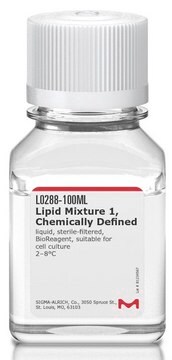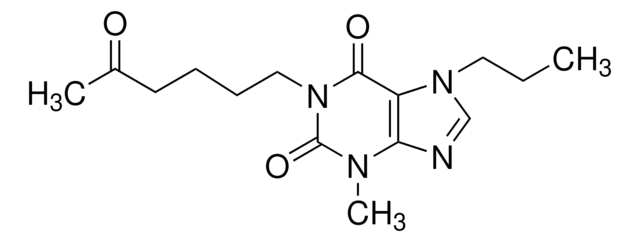Wichtige Dokumente
T1395
DL-α-Liponsäure
suitable for cell culture, BioReagent, ≥99%
Synonym(e):
(±)-1,2-Dithiolan-3-valeriansäure, 6,8-Dithiooctansäure, DL-6,8-Thioctsäure, Lip(S2)
About This Item
Empfohlene Produkte
Produktlinie
BioReagent
Qualitätsniveau
Assay
≥99%
Methode(n)
cell culture | mammalian: suitable
Löslichkeit
ethanol: 50 mg/mL
SMILES String
OC(=O)CCCCC1CCSS1
InChI
1S/C8H14O2S2/c9-8(10)4-2-1-3-7-5-6-11-12-7/h7H,1-6H2,(H,9,10)
InChIKey
AGBQKNBQESQNJD-UHFFFAOYSA-N
Angaben zum Gen
human ... ACHE(43) , BCHE(590)
rat ... Adra1a(29412) , Adra1b(24173) , Adra1d(29413)
Suchen Sie nach ähnlichen Produkten? Aufrufen Leitfaden zum Produktvergleich
Allgemeine Beschreibung
Anwendung
- for induction of eryptosis in erythrocytes
- as a constituent in NS21 media for neuronal cultures
- to evaluate its effect on liver energy metabolism by high performance liquid chromatography (HPLC) and assessing mitochondrial function by mitochondrial gene expression studies in lipopolysaccharide (LPS) pre-treated mice
- to elucidate its effect on paraquat poisoning in lungs
Biochem./physiol. Wirkung
Sonstige Hinweise
Signalwort
Warning
H-Sätze
Gefahreneinstufungen
Acute Tox. 4 Oral - Aquatic Chronic 2 - Eye Irrit. 2 - Skin Irrit. 2 - Skin Sens. 1
Lagerklassenschlüssel
11 - Combustible Solids
WGK
WGK 2
Flammpunkt (°F)
Not applicable
Flammpunkt (°C)
Not applicable
Persönliche Schutzausrüstung
dust mask type N95 (US), Eyeshields, Gloves
Hier finden Sie alle aktuellen Versionen:
Besitzen Sie dieses Produkt bereits?
In der Dokumentenbibliothek finden Sie die Dokumentation zu den Produkten, die Sie kürzlich erworben haben.
Kunden haben sich ebenfalls angesehen
Artikel
How lipoic acid (thioctic acid) and other cell culture components affect the performance of serum-free, protein-free cell culture systems used for biomanufacturing heterologous proteins including monoclonal antibodies.
Oxidative stress is mediated, in part, by reactive oxygen species produced by multiple cellular processes and controlled by cellular antioxidant mechanisms such as enzymatic scavengers or antioxidant modulators. Free radicals, such as reactive oxygen species, cause cellular damage via cellular.
Antioxidants protect biological systems from oxidative damage produced by oxygen-containing free radicals and from redoxactive transition metal ions such as iron, copper, and cadmium.
Unser Team von Wissenschaftlern verfügt über Erfahrung in allen Forschungsbereichen einschließlich Life Science, Materialwissenschaften, chemischer Synthese, Chromatographie, Analytik und vielen mehr..
Setzen Sie sich mit dem technischen Dienst in Verbindung.












